Year of the Bird
Air Date: Week of January 19, 2018
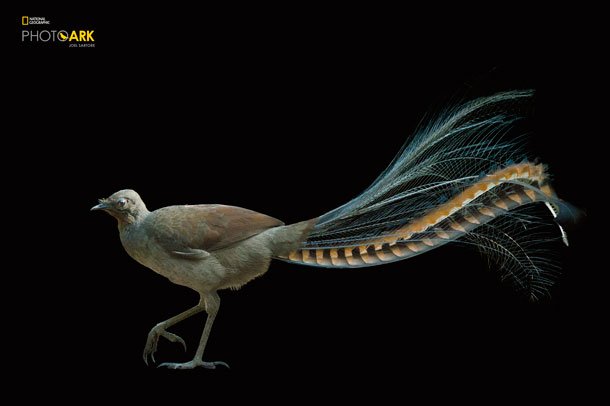
Australia’s superb lyrebird is a masterful mimic. To attract a mate, a male riffs on the calls of other birds in the forest while shaking its splendid tail feathers overhead. Captive birds have been recorded aping the sounds of chain saws, car alarms, and camera shutters. (Photo: Joel Sartore / National Geographic Photo Ark)
National Geographic, the National Audubon Society and other conservation groups, have declared 2018 the Year of The Bird to celebrate the centennial of the Migratory Bird Treaty Act. National Geographic writer and novelist Jonathan Franzen is a keen birder who wrote Nat Geo’s January cover story. He tells host Steve Curwood how a walk in New York City’s Central Park opened his eyes to the pleasures of birdwatching, why the Treaty was necessary a century ago and the many perils that birds still face today.
Transcript
CURWOOD: It’s Living on Earth, I’m Steve Curwood.
[LYREBIRD MAKING INDUSTRIAL SOUNDS – HAMMER, SAW, DRILLING] https://www.youtube.com/watch?v=C0ZffIh0-NA
CURWOOD: That strange, rather industrial racket, is not, as you might imagine, a construction site but a Lyrebird, native to Australia, which spent time near a construction zone and learned to mimic the sounds it heard there.
The Lyrebird is just one of nearly 10,000 species of birds living today and being celebrated in this year of the bird. As we mentioned earlier, National Geographic, along with Audubon and several other bird conservation organizations, have declared 2018 the Year of the Bird, in celebration of the centennial of the Migratory Bird Treaty Act. Nat Geo will feature stories about birds for the rest of the year. The January cover story, “Why Birds Matter,” was written by National Geographic writer and novelist Jonathan Franzen, who joins me now from Santa Cruz, California. Welcome to Living on Earth!
FRANZEN: It's great to be here. Thanks.
CURWOOD: So, tell me a bit about the Migratory Bird Treaty Act that's being celebrated this year. Why was it necessary back in 1918, and what does it do today?
FRANZEN: You know, when Europeans first came to North America, they were overwhelmed by the sheer quantity, not to mention the diversity of birds in North America. The sky going black with Passenger pigeons, just unbelievable richness of birds. Around the end of the 19th century suddenly people noticed, Uh–oh, the birds are gone. And in fact, the Passenger pigeon, Carolina parakeet, extinct. Egrets were on the verge of extinction because of the fashion in collecting them for their feathers. And so suddenly in the space of about 20 years, right around the same time that Teddy Roosevelt and others were advocating for a national park system, we had the invention of bird conservation. This saw the creation of the Audubon Society, and then it also - the capstone for all of that was the Migratory Bird Treaty Act.
CURWOOD: So, what exactly is this Migratory Bird Treaty Act, and who is it a treaty with?
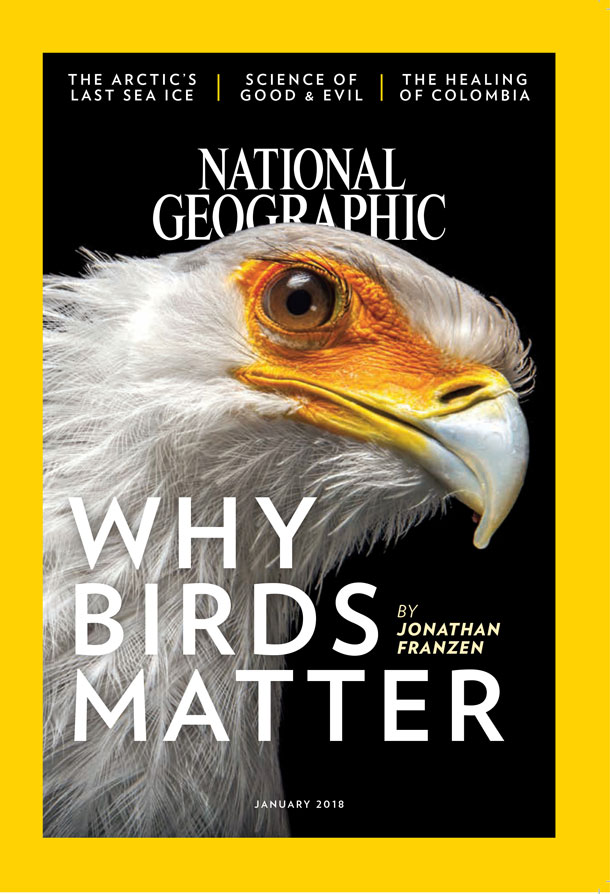
The January 2018 cover of National Geographic. (Photo: National Geographic)
FRANZEN: It's a treaty with Canada and Mexico, and it recognized that a lot of the birds we consider our own are actually shared with other countries. Now, of course, in the US, it's not just Canada and Mexico, it's all of South America where many of our migrants go, but these are our near neighbors and it was understood we as a nation have an obligation not to kill Canada's birds and vice versa, and the same thing for Mexico. So, basically there was a treaty signed, we won't kill each other's birds. And then there had to be a law to enforce that treaty, which basically made it illegal to kill any migratory bird except one of the huntable species, which is to say all songbirds. You couldn't kill a songbird in the US without breaking the law.
CURWOOD: Indeed. By the way, Jonathan, I have to ask, are you a birder? Would you consider yourself a birder?
FRANZEN: [LAUGHS] Yeah, I'm a bit of a birder. You know, it was migration that got me into birds. I've been a very urban creature. I was a New York person, lived in Manhattan and I had a then new girlfriend whose sister and brother-in-law were birders and they came down to see us in Manhattan and said, "Let's go birding in Central Park." And I thought -- I walked in Central Park every day. I've been walking in Central Park for years. I knew it like the back of my hand. They stuck binoculars in my hand. We walked out there and they started pointing things out, like, "Here's a warbler in a tree." I'm hearing a warbler. "That's a Northern Parula. Take a look at that." And I look up and here's this you know little three-and-a-half inch, four inch, long bird with this bright egg-yolk colored throat and this slaty back and cool eye patterns and it's like, "What is that?"
And for the next four hours it was a series of “are you kidding me?” We saw maybe 60, 70 species of birds in one afternoon. It was a brilliant May weekend and all the birds were coming through, and I had the sense I hadn't since high school when I realized what people were talking about when they talked about sex, like, oh, now I get it!
[CURWOOD LAUGHS]
FRANZEN: There was this huge hidden dimension to the world that was suddenly visible to me, and all I had to do to find out more about it was to go out by myself with binoculars.
CURWOOD: So, the title of your article in National Geographic is "Why Birds Matter". So, why do birds matter?
FRANZEN: [SIGHS.] Well, you can make a case that birds matter because they are valuable indicators of the health of natural systems, local ecosystems, larger ecosystems. If you go to an area that once was full of birds, and you can't find any birds, it probably means there's something very wrong with the ecosystem. That's a useful argument, although frankly you don't need birds to tell you when a forest has been cut down. You can also make an argument the birds matter because they do serve various economic functions. They do rodent and insect control. They are great pollinators. They are great seed distributors, but the basic fact is that birds are a net drag on our economy. They eat more than they give.
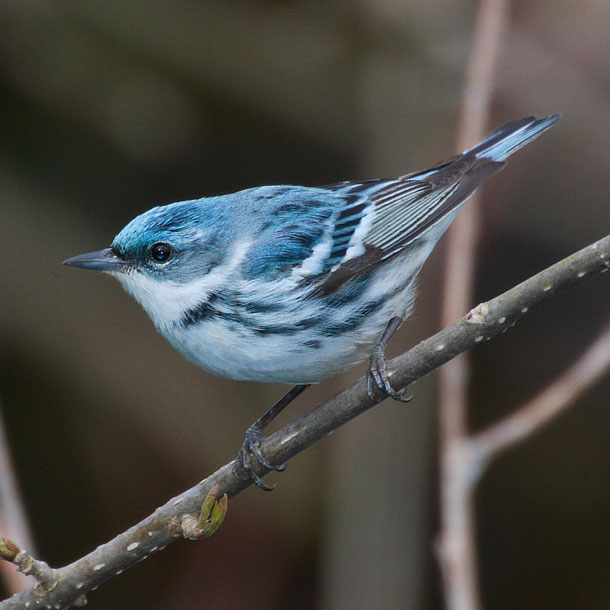
The Cerulean Warbler. (Photo: Wikimedia Commons)
[CURWOOD LAUGHS]
FRANZEN: Seriously! I mean, I actually -- I planted some blueberries behind our house knowing the birds would get them, but I thought maybe I'll get a cup or two of blueberries. No, every last blueberry gone. They're very good at that and I was fine because I actually like the mockingbird that had them. But -- no, so they will not pull their weight, and so if you're only metric is economic, you can't really make a good case for birds.
CURWOOD: Why do birds matter to you?
FRANZEN: So, birds are not just a vital part of nature, but they're a singular instance of nature because they have been world-dominating creatures for 65 million years. They are this brilliant adaptation of the original dinosaurs. They are feathered flying dinosaurs that managed to escape the big extinction event 65 million years ago and populate the entire world, and even now they are more widespread than any other kind of creature, including human beings. They're out in the middle of the most remote ocean, they're in the driest desert, they're in the middle of Antarctica in winter - not the middle, but the edge of that Antarctica in winter. If you care about the natural world that we came out of, you ought to respect these creatures that were the great thing that happened before human beings came along.
CURWOOD: Well, we're celebrating the centennial of the Migratory Bird Treaty Act, so let's talk about some migratory birds. Jonathan, tell me about the Cerulean warbler.
FRANZEN: So, in North America, about half the birds that we have don't spend the whole year within our national boundaries, and especially many of the more colorful ones, including the Cerulean warbler, which is this tiny little bird, the male of which is bright blue, incredible little warbler. It typically will make a migratory journey of 5,000 miles or more in each direction. They like to winter in the cloud forest in northern South America. You can see them in Peru and Ecuador and then come spring they make their way - and again we're talking about a bird that weighs you know as much as a pencil or less - makes its way all the way back typically to West Virginia or New Jersey. And in the case of a particular Cerulean warbler that I heard about from a brother-in-law of mine, they're very rare in Massachusetts. There are only a couple of breeding pairs in all of Massachusetts, and so when you every spring go out to a location and you see a male Cerulean warbler in the same tree, you're - you've got a pretty good bet that that one bird has flown all the way to Peru and all the way back and found the same tree. And it may very well even like the same branch, and to me when you think of the tininess of that bird, the tininess of its brain, the fact that it managed to navigate through all of these hazards 6,000 miles south and then another 6,000 miles north and find the same tree again, it's just absolutely incredible to me.
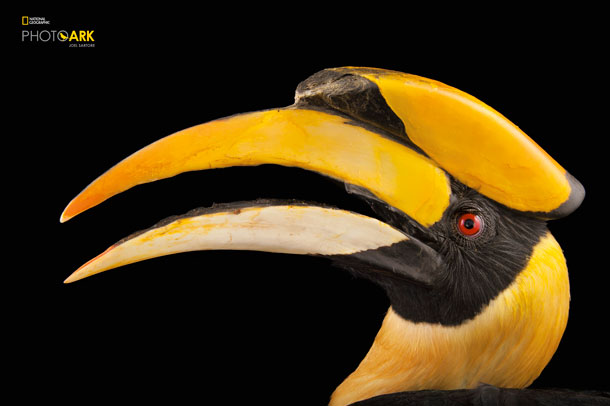
With its massive bill and casque and a wing span approaching six feet, the great Hornbill is king of the jungle skies in Southeast Asia. It adorns its black and white feathers with a yellow-tinted oil secreted from a gland near its tail. (Photo Joel Sartore / National Geographic Photo Ark)
[CERULEAN WARBLER CHIRPING]
CURWOOD: Such a cool song that it has.
[CERULEAN WARBLER CHIRPING]
FRANZEN: Yeah, that's it. When you're walking down a road and you hear that you say, "Wow, it's a Cerulean Warbler!" They're actually rather hard to see because they like the canopy or the mid-canopy of trees that are leafing out, so you can hear it and it will drive you crazy for 20 minutes until you find it.
CURWOOD: Talk to me about the dippers which have, should we say, a rather interesting way of getting around?
FRANZEN: Yeah, the old name for the dipper is the water ouzel, and it's a bird you find in the American west. It has a truly unique feeding style, it will fly from rock to rock, but in order to feed, it feeds on these aquatic insects and it essentially jumps in the water and walks on the bottom of this fast flowing stream picking up these little insects from the bottom of the stream, you know, and then it will pop out to catch its breath and then it will go back under. So, yeah, it's the strangest thing because it's like a small robin, it's this little thrush that you expect to be seeing in a front lawn or in a tree or something. No, it's actually disappearing for a minute at a time because it's walking on the bottom of the stream. It's incredible.
CURWOOD: Let's talk about the European swifts. Now, they can stay aloft for nearly a year before coming back to land. How do they do that?
FRANZEN: Eating is easy because swifts basically catch insects in the air. Sleep...big problem, and the way swifts, we think, have solved it, it's difficult to actually monitor the brain activity of a swift that's flying 2,000 meters up continuously, but the best guess based on looking at other birds is that it has the capacity to sleep one half of its brain at a time, leaving the other...it's kind of like a plane with two pilots. One of them sleeps while the other one looks straight ahead and keeps the plane aloft. Again, it's speculative but there's really no other way to explain it because everything needs to sleep and how else could you stay aloft if you don't have that capacity?
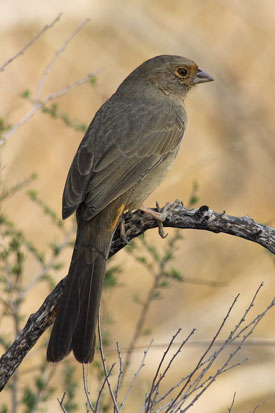
California Towhee. (Photo: Cameron Rognan/Cornell Lab of Ornithology)
CURWOOD: Jonathan, what's your favorite bird?
FRANZEN: I love the California towhee, and I love it because it's so easy to overlook. Most people see this small to medium sized songbird hopping around on the ground, dull brown. It's everything that might turn a person off bird watching, and the towhee is a great bird because it's a bird you can see every day, it becomes a constant companion. When I was first getting into birds the towhee was the bird I was seeing every day- it’s probably beyond reason, but I formed this close, close bond with it. I thought, “Why this is a magnificent small creature that no one gives a second look to,” and the more I look at it the more beautiful I find it.
CURWOOD: Let's take a listen.
[TOWHEE CHIRPING]
FRANZEN: One of the many, many lovable qualities of towhees, is it's a relatively rare bird that mates for life, and once they have paired off the male and the female will sing duets to kind of announce to the world, we're paired up, no other comers need apply.
CURWOOD: What are the threats to birds these days?
FRANZEN: The biggest threat to birds and to wildlife in general is loss and fragmentation of habitat. And interestingly, kind of shockingly, the number one threat after habitat loss is outdoor cats. The reliable scientific estimates of the toll on North American birds, just US birds in a single year is phenomenal. It's on the order of one to three billion birds every year being taken by feral cats and free roaming cats.
After that, probably the next biggest worry is collisions. There's really nothing we can do about a lot of that. We've all had the experience of a robin or a flicker or something crashing into the kitchen window. There are things we can do to mitigate that. The toll is particularly high in cities that have skyscrapers whose lights attract birds. There are some very good initiatives going on to get cities to black out their high buildings during critical migration times, and the third major threat appears to be agriculture in general, but particularly the pesticides and it is worrisome that the new Environmental Protection Agency Director Scott Pruitt does not seem interested in rolling back some of these pesticides that had been studied and were about to be banned. But there's been a tremendous decline in birds that depend on open land, grassland birds and things like whippoorwills that feed on insects about open fields with the pesticides being the likely culprit for those declines.
CURWOOD: Wow, that sounds rather daunting. So, what can the average person listening now do to help birds?
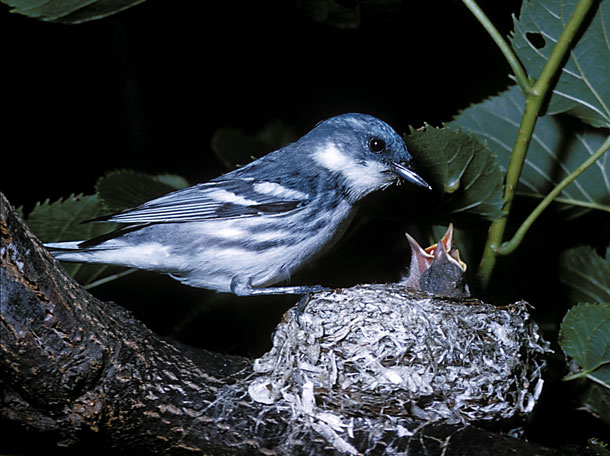
Cerulean Warbler. (Photo: Bill Dyer/Cornell Lab of Ornithology)
FRANZEN: In a way it doesn't matter what you do as long as you do something. If all you do is pick up trash or help build predator proof fences down at the local Audubon reserve or help remove invasive plants from a wetland or something, obviously contributing to just some of the organizations that have the have the resources to do larger scale conservation work at the level of landscape or even country, that's a great thing, and in a very practical way you can write your Congressman right now and say, "Don't mess with the Migratory Bird Treaty Act", which is where we started this hour talking about that amazing act which is under threat in the current Congress and it's also under threat by the Department of Interior which wants to basically defang that law and make it OK to kill birds without having paid any consequences. So, the worst thing is to just ignore it, because once you pay attention you might fall in love, and once you fall in love, then you have to do something.
CURWOOD: Jonathan Franzen wrote the January cover story for National Geographic, "Why Birds Matter". Jonathan, thanks so much for taking the time with us today.
FRANZEN: It's been a pleasure. Thanks a lot, Steve.
Links
Living on Earth wants to hear from you!
Living on Earth
62 Calef Highway, Suite 212
Lee, NH 03861
Telephone: 617-287-4121
E-mail: comments@loe.org
Newsletter [Click here]
Donate to Living on Earth!
Living on Earth is an independent media program and relies entirely on contributions from listeners and institutions supporting public service. Please donate now to preserve an independent environmental voice.
NewsletterLiving on Earth offers a weekly delivery of the show's rundown to your mailbox. Sign up for our newsletter today!
 Sailors For The Sea: Be the change you want to sea.
Sailors For The Sea: Be the change you want to sea.
 The Grantham Foundation for the Protection of the Environment: Committed to protecting and improving the health of the global environment.
The Grantham Foundation for the Protection of the Environment: Committed to protecting and improving the health of the global environment.
 Contribute to Living on Earth and receive, as our gift to you, an archival print of one of Mark Seth Lender's extraordinary wildlife photographs. Follow the link to see Mark's current collection of photographs.
Contribute to Living on Earth and receive, as our gift to you, an archival print of one of Mark Seth Lender's extraordinary wildlife photographs. Follow the link to see Mark's current collection of photographs.
 Buy a signed copy of Mark Seth Lender's book Smeagull the Seagull & support Living on Earth
Buy a signed copy of Mark Seth Lender's book Smeagull the Seagull & support Living on Earth

